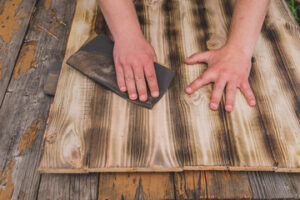Cabinet refinishing is a surface-level upgrade that allows you to update your cabinets with new color without the cost and time commitment of replacement. It can also provide a more dramatic transformation.

However, refinishing isn’t a viable option for many types of cabinetry. Most solid color cabinet doors are made of medium-density fiberboard (MDF), which cannot be stained. Contact Cabinet Refinishing Sacramento for professional help.
Cabinet refinishing is more than just applying new coats of paint to your cabinets. It involves stripping the existing stain or paint, and often resanding to create a smooth surface. This allows you to change the color of your cabinets, as well as update the look with updated doorknobs and drawer pulls. This can be a costly project, so it’s important to plan accordingly and hire a qualified contractor.
To prepare for your cabinet refinishing, clear out your kitchen or workspace and remove all items from the cabinets. This will give you a clean canvas and prevent accidental paint splatters or spills on your belongings. If you have children or pets, it’s a good idea to keep them away from the work area as well. Keeping everything organized will make the re-install process much easier once the project is complete.
Begin by cleaning the cabinets with a degreaser or a mix of water and vinegar to remove grease, grime and other residues from the surfaces. This is important for a long-lasting finish.
After a thorough cleaning, sand the surface of the cabinets, drawers and doors with a medium grit sanding sponge or 180-grit sandpaper on a random orbital sander. This will scuff the surface to provide “tooth” for the new primer and paint and allow the sanding dust to be removed with a vacuum and tack cloth.
Next, apply a high-quality primer. This is a critical step in the refinishing process as it provides an extra layer of protection, improves adhesion and helps reduce imperfections. It is also a great way to help your final paint job last longer.
Once the primer is dry, it’s time to start reassembling your cabinets. Ensure that each cabinet door and drawer is labeled with a number or a diagram to make re-assembling them go as smoothly as possible. This will save you from wasting time looking for the right hardware when it comes time to reinstall it.
It’s also a good idea to apply caulk along the edges of your cabinets and seams to seal any loose areas. This will prevent moisture from seeping under the cabinet and causing warping or rotting.
Stripping
Cabinet refinishing requires careful planning, including surface preparation and deciding whether to strip or not. It can be time consuming and is only a cosmetic improvement, but it can be worth the effort if your cabinets have many layers of paint or a variety of colors that you want to get rid of. To properly strip your cabinets, you’ll need to clean the surface, sand it down and apply a degreasing cleaner. This will prepare the surface for stripping and ensure that your next coat of paint will adhere to it.
Before you begin to strip your cabinets, make sure you’re in a well-ventilated area and wearing gloves and a face mask. Most stripping solutions are toxic, so you’ll want to be as safe as possible when working with them. You’ll also need to protect your countertops and floors, so be sure to cover them with plastic or paper. You’ll need to remove the hinges and hardware from the cabinet doors so you can lay them flat on a work surface and strip the old paint.
Once you’ve stripped the old paint from your cabinet doors, you can patch any holes or scratches with wood filler and sand them lightly before starting to stain. Staining is best done with oil-based primer. It’s the only type of primer that will adhere to wood, and it’s the most durable. It also has a very low VOC (volatile organic compounds), so it won’t off-gas into your home.
It’s important to use a quality stain that will last and look good on your cabinets. There are several types of stain available, including water-based, oil-based, and shellac-based. If you’re unsure which type to choose, ask your local paint supplier for advice. It’s also a good idea to try the stain out on a piece of scrap wood before applying it to your cabinets to ensure you’re happy with the color and finish.
Staining
Staining is the next step in the refinishing process. If your cabinet doors are made of wood or MDF, then staining them is a great option. The doors will need to be stripped first (which requires a chemical stripper or lots of sanding) and then the doors can be stained in whatever color you choose. This is not an option for thermofoil doors or laminates – paint doesn’t adhere well to these materials and will not hold up over time.
Once the cabinets are stripped, they need to be sanded again to create an even surface. Then the cabinets should be conditioned before staining, which helps the stain stick better to the wood. Apply the conditioner with a brush and let it dry according to the manufacturer’s instructions. Once the conditioner is dry, scuff the cabinet surfaces lightly with extra fine steel wool to help the stain adhere.
When it comes to stain, you have a few choices: oil-based, water-based, and gel. Oil-based stains soak into the wood and offer richer tones, while water-based stains are more eco-friendly but can raise the grain of the wood and require more sanding. Gel stains are a middle ground that sit on top of the wood and can give it a lighter finish.
Before you stain, make sure to use a dust mask and protective gloves when working with chemicals and sanding. Once you’ve finished staining, be sure to seal the cabinets with a protective varnish to keep them looking great for years to come!
There are a few pros to staining your cabinets:
1. It highlights the natural beauty of the wood and its patterns.
2. Stains require less maintenance than painted cabinets, especially in darker tones.
3. You can purchase touch-up markers that match or are close to your stain color, making it easy to fix scratches and other minor problems as they arise over the years.
As you can see, there are a lot of steps to taking care of your cabinets when refinishing them, but it’s worth it in the end! Staining your cabinets is a great way to freshen up your kitchen without spending the money on new cabinetry.
Painting
Painting your cabinets is a quick and easy way to give your kitchen a new look. There are many different kinds of paint available, so you can choose one that fits your style and budget. You can even find specialized cabinet paint that is designed to withstand moisture and stains.
Before you start painting, it is important to make sure that your cabinets are clean and dry. This will help the paint to adhere properly and prevent peeling or cracking. It is also important to use a good quality primer. There are several different types of primers available, including stain-blocking and adhesion primers. Stain-blocking primers are especially useful for hiding stains and preventing them from bleeding through the top coat. However, they can be more expensive than other types of primers. Adhesion primers, on the other hand, are ideal for slick surfaces like laminate or glossy paint. They can be less expensive than stain-blocking primers, but they may not hide stains as well.
It is also a good idea to use masking tape to protect areas that you don’t want to paint. This will help you to focus on the areas that need it most and avoid getting paint in places where it isn’t needed. If you are using oil-based paint, be sure to wear a respirator mask and open windows for ventilation. It is also a good idea to take the time to wipe down each piece of cabinetry with a damp cloth before you start painting. This will remove any dust and dirt that can affect the finish of your project.
Once you have finished sanding and priming your cabinets, it is important to let them dry completely before you begin painting. It usually takes at least overnight, and in some cases a few days, for the primer to dry completely. You should also allow the paint to cure fully before you use your cabinets again. This can take weeks, or even months, depending on the type of paint you have used.
By following these steps, you can ensure that your painting project will be a success. If you aren’t comfortable taking on this project yourself, a professional can help you to achieve the perfect results.

